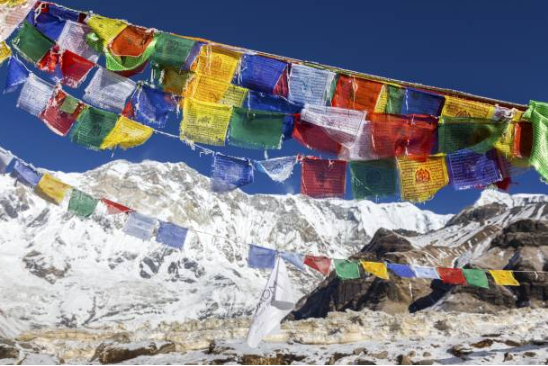The Annapurna Circuit trekking is widely regarded as one of the best trekking routes in the world, offering an extraordinary journey through diverse landscapes, cultures, and ecosystems. Located in the heart of Nepal, the trek takes adventurers around the Annapurna Massif, providing stunning panoramic views of the world’s highest peaks. The circuit passes through subtropical forests, alpine meadows, high deserts, and traditional villages, making it a versatile and immersive experience for trekkers of all levels. With its rich natural beauty, cultural significance, and challenging terrain, the Annapurna Circuit remains one of the most sought-after trekking experiences in Nepal.
Trekking Overview
The Annapurna Round Trek is a high-altitude trek that typically takes 12 to 21 days to complete, depending on the pace and itinerary chosen. The trek starts from the lowland town of Besisahar, located 170 kilometers west of Kathmandu, and gradually ascends to the Thorong La Pass (5,416 meters), one of the highest trekking passes in the world. After crossing the pass, trekkers descend to the village of Muktinath and complete the circuit by returning to Jomsom. The entire route covers a distance of approximately 160 to 230 kilometers, with varying altitudes ranging from 800 meters to over 5,400 meters.
The circuit offers a unique opportunity to experience the contrasts of Nepal’s diverse geography. From the subtropical forests and rice terraces in the lower elevations to the arid, Himalayan landscapes above the tree line, trekkers are treated to a changing environment as they ascend. The Annapurna Circuit also takes trekkers through various ethnic communities, including the Gurung, Magar, Thakali, and Tibetan-influenced populations, providing valuable cultural insights.
Highlights of the Trek
- Thorong La Pass
The most challenging and rewarding part of the Annapurna Circuit Trek is crossing the Thorong La Pass, located at an altitude of 5,416 meters. This high-altitude pass offers trekkers a sense of accomplishment and unparalleled views of the surrounding peaks, including Annapurna, Dhaulagiri, and Machapuchare. The ascent to Thorong La is strenuous, and it’s essential to take precautions for altitude sickness, but the breathtaking views and the sense of achievement make it all worthwhile.
- Diverse Landscapes
The Annapurna Circuit offers a variety of landscapes, making it a visually stunning trek. The lower sections of the trek are characterized by lush subtropical forests, terraced fields, and rushing rivers, while the mid-section reveals alpine meadows and rhododendron forests. As trekkers ascend to higher altitudes, the landscape transforms into an arid, Tibetan-like plateau, dotted with Buddhist stupas and prayer flags. The scenery along the route is diverse, with each section offering something unique, from lush greenery to stark, barren mountains.
- Cultural Immersion
The trek takes trekkers through a series of traditional villages, each offering a glimpse into the culture and way of life of the local people. The communities along the Annapurna Circuit are home to various ethnic groups, including the Gurung, Magar, Thakali, and Tibetan refugees. Villages like Manang and Marpha are rich in cultural heritage, with ancient monasteries, temples, and traditional houses. The local people are known for their hospitality, and trekkers can enjoy local food, such as dal bhat (lentil soup) and momo (dumplings), while interacting with the friendly locals.
- Natural Beauty and Wildlife
The Annapurna Conservation Area, which encompasses the Annapurna Circuit, is a biodiversity hotspot, home to a wide variety of flora and fauna. The lower elevations are lush with rhododendron and oak forests, while higher altitudes are characterized by alpine meadows. Wildlife in the region includes species like the Himalayan tahr, snow leopards, musk deer, and various birds, such as the Himalayan griffon vulture and pheasants. The area’s rich flora and fauna add to the trek’s allure, offering trekkers an immersive experience in nature.
Difficulty and Preparation
The Annapurna Circuit Trek is a moderate to challenging trek, requiring good physical fitness and stamina. The altitude and rugged terrain can be demanding, particularly when crossing Thorong La Pass. Proper acclimatization is crucial to prevent altitude sickness, and trekkers are advised to take rest days to allow their bodies to adjust. The trek involves long days of walking, sometimes on steep and rocky terrain, so having a reasonable level of fitness is essential.
Trekking with a guide or porter is highly recommended for those unfamiliar with high-altitude trekking or those seeking a more comfortable and culturally immersive experience. The weather in the region can also be unpredictable, with temperatures dropping below freezing at higher altitudes, so trekkers should pack appropriate clothing and gear, including warm layers and a good sleeping bag.
Best Time to Trek
The best time to trek the Annapurna Circuit is during the spring (March to May) and autumn (September to November) seasons when the weather is stable, and the views are clear. During these months, the region experiences mild temperatures, and the trails are well-maintained. It is advisable to avoid trekking during the monsoon season (June to August) due to the risk of landslides and slippery trails.
Conclusion
The Annapurna Circuit Trek offers one of the most complete trekking experiences in Nepal, combining high-altitude challenges with stunning natural beauty and cultural immersion. Whether it’s crossing the Thorong La Pass, exploring the diverse landscapes, or interacting with the warm and welcoming local communities, the trek provides a sense of accomplishment and adventure. With proper preparation, this trek remains one of the world’s most iconic and unforgettable trekking experiences.
